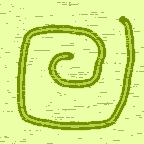
Directly above is a faux postage stamp sheet collage I started almost a year ago. Here is how it began. I was sorting through some old papers and I found two computer printouts that another artist, nonlocal variable, had sent to me as mail art a long time ago. The printouts were of faux postage designs featuring computer manipulated photos of Ray Johnson – an artist who is considered by many to have been the founder of the modern mail art movement. Ray Johnson is the subject of a lot of mail art projects. I participated in one such project myself in the fall of 2019. I also featured some pictures of Ray Johnson in my #12daysoftomsbeard art project because when my husband Tom is clean shaven, he looks so much like Ray Johnson that when I was working on the mail art project, Tom thought at first glance that I was using pictures of him!
In the same stack of old papers, I found an advertising booklet that had black and white portraits similar in size to the Ray Johnson portraits in the old printouts. At least they were close enough in size to possibly be used together in a faux postage design. I took a faux postage base I made a long time ago and use a lot and started laying down the portrait pictures on it to get ideas.
I originally had the idea to put the smaller portraits inside silhouettes of the Ray Johnson images and alternate the two on the stamp sheets. I made templates from scrap chipboard to help me cut multiple silhouettes and negatives of silhouettes from colorful paper scraps to play around with. I ended up saving the smaller black and white portraits for a future project and I kept the Ray Johnson images for this set of stamp sheets.

When I make chipboard templates for a collage or other project, I keep them in folders named after the project they were made for so if I want to I can use them over and over for related art projects. If I’m really turned on by the designs, I am likely to use the templates many times. I also made a bunch of rectangle templates to go with my faux postage stamp background, using tracing paper as an aid to finding which piece goes where on the collage. I numbered the chipboard pieces and their position on the tracing paper to help me get organized the next time I use the templates.

I arranged the different colored small rectangles on my collage sheets where I wanted them. I glued on the Ray Johnson images, some miscellaneous found images, and used black permanent Sharpie markers and stencils to draw on some bold designs in black marker. I printed out postage stamp related words, phrases and images with black permanent stamping ink onto white blank sticker paper, cut them out and stuck them on my collages to make them look even more like sheets of imaginary stamps.

I thought they needed more texture to look finished so I used freehand drawing plus stencils again to apply marks with paint markers and colored pencils. The final marks I applied were a bit of colored pencil outlining the white sticker pieces to make them look more integrated with the whole.
Here are the commercial stencils I used in the project. They were designed by the Crafter’s Workshop company:
I probably will display the resulting “stamp” sheets as framed collages some time in the future. I’ve scanned them into the computer where they will be reduced to a smaller size so that they look more like real postage stamps. Then I’ll print out and distribute the finished stamp sheets to some other mail artists. Many mail artists collect faux postage as art or use the resulting stamps as part of another piece of mail artwork.
























